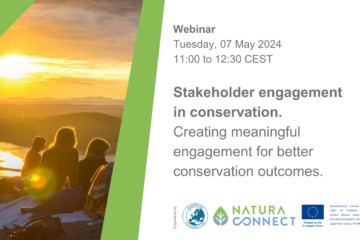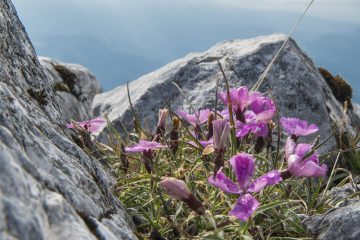The Carpathian Convention marks its 20th anniversary with a new Biodiversity Framework and a transboundary protected wetland
Belgrade, Serbia – Celebrating the 20th anniversary of the Carpathian Convention, environment ministers and senior officials from the Carpathian countries gathered at their seventh Conference of the Parties (COP7) in Belgrade, Serbia, and adopted the Carpathian Biodiversity Framework, established the transboundary Ramsar site, and presented the Assessment of climate change risks and adaptation options for the Carpathian forest ecosystems and their services, among other decisions.
The Carpathian Convention – which brings together the Czech Republic, Hungary, Poland, Romania, Serbia, Slovakia and Ukraine – was established in 2003 to protect the second largest mountain range in Europe, home to nearly 4,000 plant species and the largest pristine forests in Europe. It is also inhabited by the richest populations of large carnivores on the continent. The Secretariat of the Carpathian Convention is hosted by the United Nations Environment Programme (UNEP).
The new Carpathian Biodiversity Framework is a comprehensive instrument supporting the implementation of the Kunming-Montreal Global Biodiversity Framework at the Carpathian level, translating the global goals and targets into concrete actions by various stakeholders in the region.
“We are the first region in the world to apply the Kunming-Montreal Global Biodiversity Framework at the regional level, touching all sectors of society for a real transformative change,” said Harald Egerer, Head of UNEP Vienna Programme Office, Secretariat of the Carpathian Convention. “We must take action [to not only address climate change, conserve our nature, and combat pollution], but also in the current crisis and the aggression against one of our Parties. We will never stop our cooperation.”
As part of the Carpathian Biodiversity Framework, the Carpathian countries also committed to achieve the Carpathian Vision 2050, where, by 2050, “the Carpathians are a thriving and sustainable region, where people live in harmony with nature. The biodiversity and natural beauty of the Carpathians are conserved, restored, and wisely used, providing a healthy environment and essential ecosystems services for all people of the region and beyond.”
“We should celebrate the gains of the last two decades. But we cannot rest on our laurels. A potentially devastating combination of climate change, nature loss and pollution is putting new pressure on the Carpathian region,” said Elizabeth Mrema, Deputy Executive Director of UNEP. “We are happy to see that the Carpathian Convention is strengthening its collaboration with other biodiversity-related, as well as chemicals-related accords, to implement the Global Biodiversity Framework in an overarching and integrated manner.”
At the COP7, the three-year term presidency of the Carpathian Convention was transferred from Poland to Serbia. For its presidency from 2023-2026, Serbia announced its priority to address the triple planetary crisis of climate change, biodiversity loss, and plastic pollution, with a special emphasis on wetlands, protected areas, which shall be strengthen by interregional cooperation and closer relations with the European Union.
Towards this aim, the environment ministers of Serbia and Romania sealed the establishment of a transboundary Ramsar site in the Đerdap gorge (Iron Gate) National Park along the Danube River. The wetland site spans the border between Serbia and Romania.
Also, a focus at the COP7 was the importance of Carpathian forests and how the detrimental impacts of climate change require adaptive management solutions. Forest ecosystems represent a precious resource in the Carpathians, harbouring a wealth of ecological, economic and cultural values. Thus, the presentation of the Assessment of climate change risks and adaptation options for the Carpathian forest ecosystems and their services at the COP7 represented a monumental step toward creating a roadmap for protecting Carpathian forests, especially old-growth forests. This assessment was called for at the COP6 meeting in 2020, and initiated by the Working Group on Climate Change and Working Group on Sustainable Forest Management.
Additionally, the establishment of an Inventory of Virgin Forests of the Carpathians, which the ministers described in their official declaration as “a critical step towards fortifying the protection of some of Europe’s few remaining primary forests,” further encouraged “extending the Inventory to encompass other Carpathian forests with varying degrees of naturalness.”
While the Carpathian Convention celebrated several positive actions over its 20 years of implementation, it was widely acknowledged by senior officials and local stakeholders that future immediate action must be taken to facilitate holistic environmental protection and sustainable development across all sectors.
NOTES TO EDITORS:
About the Carpathians
The Carpathian Mountains provide essential ecosystem services to millions of people who reside in the area and beyond, contributing to the health of diverse landscapes. In addition to being the home to the headwaters of major rivers, the region is a biodiversity hotspot in Europe, harbouring some of Europe’s last remaining virgin forests and the largest populations of large carnivores: lynxes, brown bears and wolves.
About the Carpathian Convention
The Carpathian Convention, a multinational environmental agreement, unites the seven Carpathian countries—Czech Republic, Hungary, Poland, Romania, Serbia, Slovakia and Ukraine—in a unique partnership to protect the natural and cultural heritage of the Carpathian region while promoting sustainable development. The Convention provides an open forum for discussion between various stakeholders; a framework for transnational cooperation across sectors; and a platform for developing and implementing transnational strategies, programmes, and projects for the protection and sustainable development of the Carpathian region.
About the UN Environment Programme (UNEP)
UNEP is the leading global voice on the environment. It provides leadership and encourages partnership in caring for the environment by inspiring, informing and enabling nations and peoples to improve their quality of life without compromising that of future generations.


